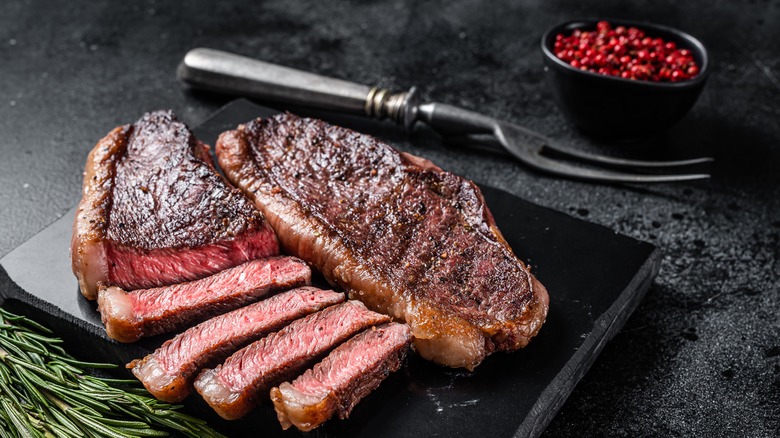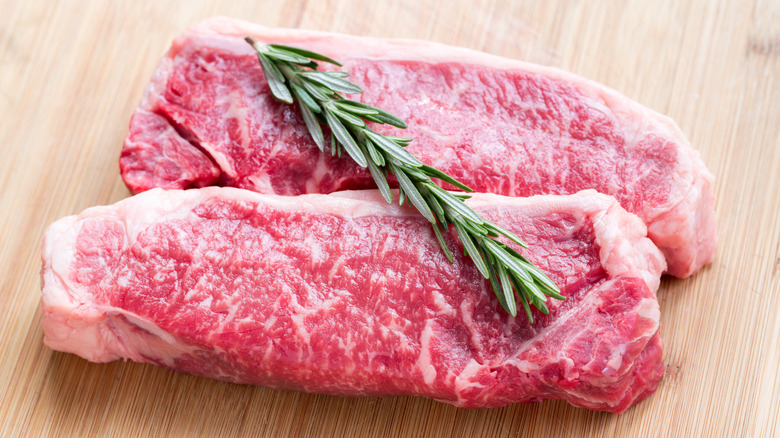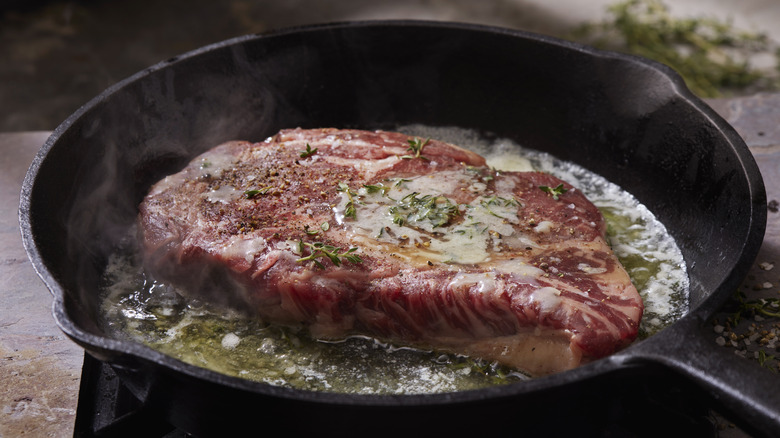Don't Bother Buying High-Quality Beef For A Delicious Braise
Braising can turn cuts of beef like brisket, which can tend towards sinewy and tough, into a fork-tender masterpiece. The cooking method, which consists of browning meat on high heat and then cooking at a lower temperature for an extended period, simmering in liquid, helps to bring the best out of many cuts of meat, and makes the best out of some seriously tough situations. However, you might want to step away from the Dutch oven next time you bring home a fine cut of steak. Like all cooking methods, braising has a time and a place and isn't always your best bet.
This is especially the case when it comes to a good cut of steak. This is according to beef expert Curtis Stone, who spoke with Food & Wine about the pros and cons of various steak cuts. Stone indicated that prime cuts of beef should not be cooked using wet methods. This is because prime cuts of beef already have a high fat content and significant marbling throughout, which makes it easier to achieve a tender result. For this reason, prime cuts tend to fare better with dry cooking methods, such as grilling. However, this doesn't mean that you have to go plain Jane when cooking your prime cut of beef. There are still plenty of ways to infuse the lean cut with some serious flavor.
More about prime steak
So what exactly is prime beef? Prime beef is one of eight grades of beef, which include choice, select, standard, commercial, utility, cutter, and canner grades of beef. These grades are not required by the USDA. However, many meat suppliers choose to pursue grading for their beef in order to make sure that the quality of their beef is on display for customers. Prime cuts are the highest grade when it comes to beef, and the category includes both Wagyu and prime rib. Prime cuts of beef have a fat content that ranges from eight to thirteen percent, making them rich in fat and plenty tender. Wagyu, in particular, is known for its marbling and rich fat content.
These cuts do best with dry cooking methods, as they do not require any extra tenderness in cooking. Their high fat content and lack of connective tissue make these cuts perfect for simple cooking methods, such as grilling or roasting. Braising your prime cut of beef would do away with many of the beef's special qualities. And with cuts such as Wagyu, a rare cook is preferred over a long braise.
How to bring out the best in your steak
So, if braising isn't the best option for your prime cut of beef, how exactly should you cook your prime cuts? Well, there is no one uniform answer, of course. Methods such as sous vide are great for the tender and delicious Wagyu beef, or rib-eye. However, a cast iron skillet or a grill top is always a safe bet for making a delicious steak. And there are a few tips that you can implement to achieve the best possible result. For one, you will want to go easy on the seasonings before cooking. Simply salting and peppering your steak a few hours prior to cooking will be sufficient.
You'll want your steak's natural flavors to shine, after all, salting beforehand can help you achieve a beautiful crust on your steak. And no, you shouldn't use regular old table salt for your steaks. Now, the level of doneness you cook your steak to depends entirely on your own preference. However, if you want your steak to have a nice, pink center, be sure not to cook it for too long. And once your steak is done cooking, make sure to let it rest for a few minutes prior to cutting. This will help to seal in all of those delicious juices, giving you the best possible steak.


